12 LinkedIn Scheduling Tools for 2024
Tired of the LinkedIn posting hustle? You’re not the only one. Many social media managers struggle with consistent and regular LinkedIn communication. Since LinkedIn isn’t just about LinkedIn company pages,...

We all want our content to sparkle. We want to be creative, we want our posts to be blockbusters and want to be social media stars.
We don’t want to analyze, though. We are constantly looking for excuses not to dig into social media statistics. Understanding social media analytics is just overwhelming and instead of giving it a go, we are just giving… up.
Today, we would like to make life easier for you by getting you through Facebook marketing analytics and showing you that there is nothing to be scared of.
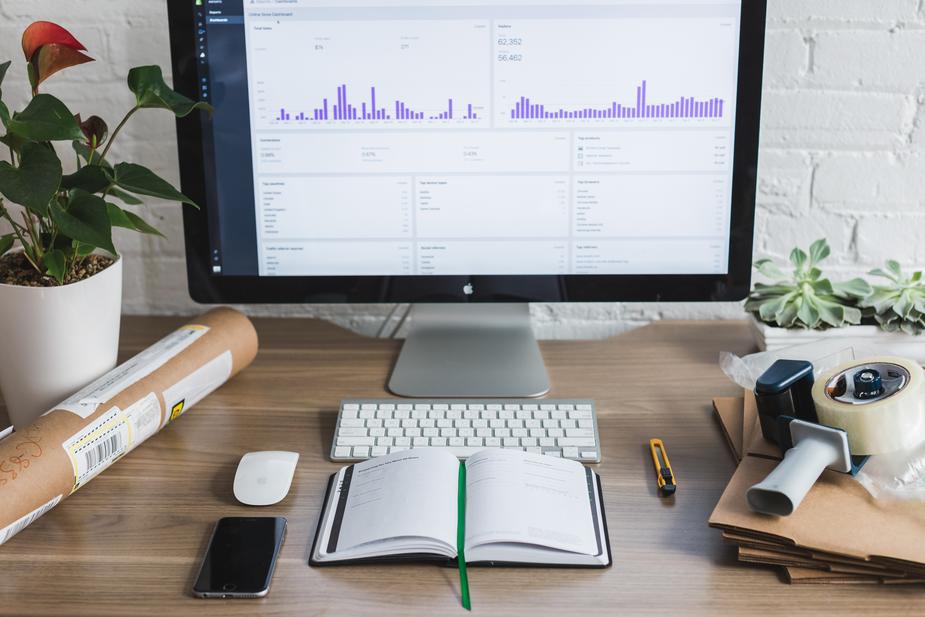
Long story short: it is a set of data reflecting your performance. Your post performance or interaction rates are included in statistics. By generating and comparing statistics, you can see whether you are heading in the right direction or your results are getting worse so you should start optimizing your strategy. Understanding social media analytics is extremely important, but we will cover it in the next paragraphs.
You can analyze organic results (such as reach or engagement) or paid results gained in ad campaigns. Facebook Ad Analytics is really advanced and can help you manage your campaigns in a more efficient way.
Why do we use social media analytics? We already mentioned one of the most important reasons: numbers do not lie and they will definitely tell you what you are doing right and where there are some areas for potential improvement.
With social media analytics, you can quickly evaluate what kind of content works for your audience, and who actually your audience is. It can turn out that you thought you were speaking to the right people, but statistics can tell otherwise.
Benefits of social media analytics are undisputable. While many businesses are present on Facebook, not many of them actually care about analytics. The outcome? Low engagement, lack of meeting KPIs or no business results despite efforts. Fixing all those mistakes may be impossible without quite a few numbers. Facebook marketing analytics, both for unpaid and paid activities, is crucial if you want to be successful.
Depending on the platform you want to analyze, you will be given some set of statistics built-in on a particular social media channel. For example, for Facebook, Facebook Analytics tools are at your disposal. Also Instagram, Twitter and LinkedIn provide some general info. You can use third-party tools to acquire some of the analytics, too.
Take a glance at Facebook marketing analytics.
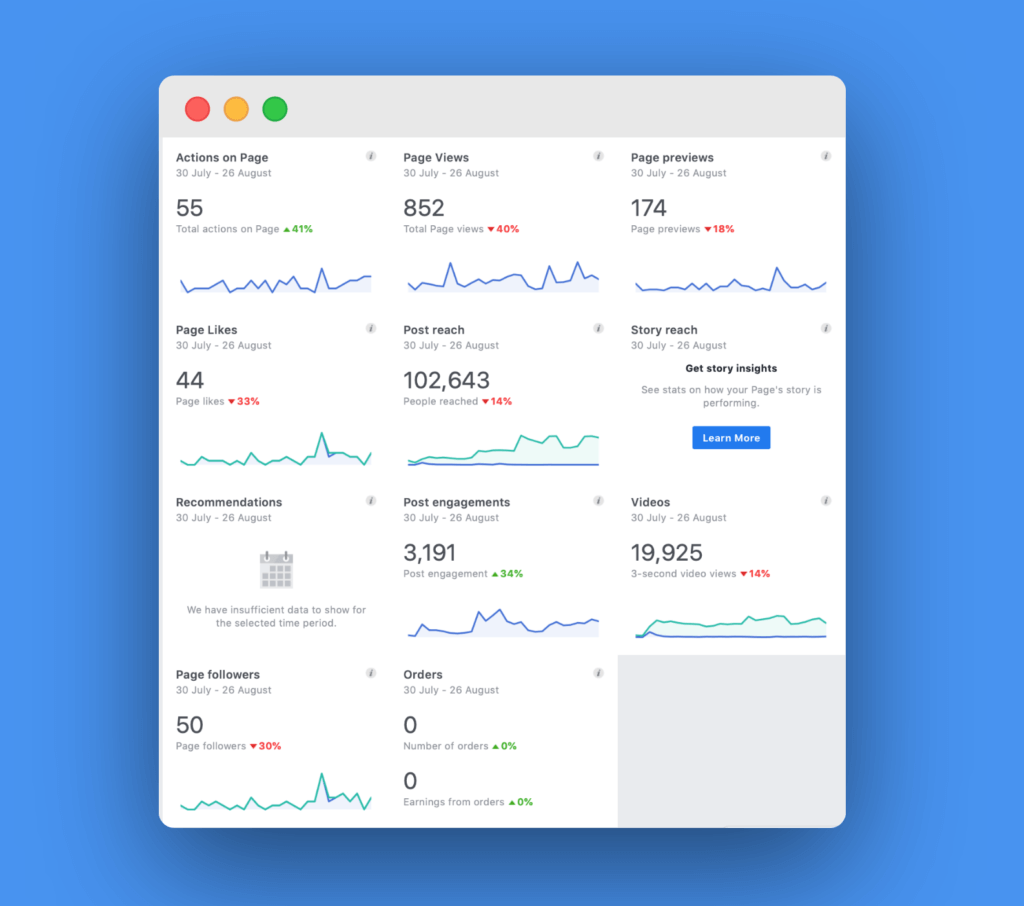
You can access the data above (of course, relevant to your Facebook Page) by clicking on Insights located in the top bar on your page.
Those statistics can be tricky for those who have never taken a look at them before. For organic results, you should only look at results displayed in blue (green ones refer to paid efforts).
What can you take out of those statistics?
It says a lot, but it can be extremely difficult for people who never really were into analytics and making some conclusions out of these statistics.
The exemplary conclusions:
Of course, you need to take into consideration a few factors that could affect those results: for example, some RTM posts or even a social media crisis. You could notice then an increased interest in your page, but not by your target group and the engagement does not have to be positive at all in the light of a crisis. Every coin has two sides.
While it is a story for another article, we owe you some explanation of the complexity of Facebook campaign analytics. We live in a social era of “Pay to Play”, where brands are indirectly forced to pay for their visibility on Facebook. This is where another set of metrics is to be analyzed.
Setting up your goals is crucial at this stage. If you aim for higher sales, your primary choice should not be raising brand awareness or engagement. If you want to get more leads, choose Lead Ads and optimize for Cost Per Lead. If you want to get more leads but via your website, optimizing for Traffic and playing with pixels can be a way to go. As long as you test out many available options, you should not make any basic mistakes from day one.
For many rookies in the world of social media, paid promotion means boosting posts with the feature available on your Page overview. However, to optimize your campaigns and use all of the options Facebook gives you, you should invest in promotion via Power Editor and Ads Manager. Why? Boosting posts only gives you the option to raise engagement. If your goal is sales, you should look at optimizing CPC, CPS or CPL. Those more advanced options, including playing around target groups and creatives a bit more, are accessible in the Power Editor, but not via classic boosting through the page. Power Editor opens the new world of advertising possibilities: from a very precise selection of campaign goals, target groups and placements, through behaviour and bidding, to CTAs, links and preparing creatives.
Long story short: you can miss the boat if you only use the “Boost post” button.
No one likes burning money. If you leave campaigns on their own, without any control, there is a possibility that something goes wrong or you leave your campaigns completely unoptimized. Even though it can be a matter of “trial and error” with small budgets – with larger budgets it can be reflected in losing a lot of money.
Optimizing your campaign means optimizing your budget and saving money, but that’s not the only reason behind optimization. By adjusting campaigns according to its current effects, you can answer quite a few questions. Does the campaign reach the desired target group? Does it, actually, even work? How can we optimize it to make it even more successful? Which persona engages with the campaign the most? Without analyzing and optimizing your campaign, you can only guess what the answers are.
Of course, not. There are many complex blog posts and books concerning this topic, so you can expect us to elaborate on this soon. For now, let’s come back to general metrics.
Depending on the goal of your ad campaign, you need to take different results into consideration and focus on a few crucial metrics within Facebook ad analytics.
For brand awareness, you may want to look at engagement and reach first. However, if your goal is to sell more product in your shop online, 3-second video views may not work wonders for you. If you want to promote your local business, e.g. restaurant, you need to be careful with targeting. Having a crazy engagement, but not among your target group, can mean that all that work was for nothing.
Is engagement overrated?
Engagement can help you:
However, you should not take engagement as the Holy Grail.
Engagement rate does not show you whether brand recognition or brand loyalty are increased. It does not show you whether someone bought, or is going to buy: even if they loved your post. That’s why you always need to choose the goal of your campaign based on your KPIs.
Engagement rate or 3-second video views are tricky. They may make you feel successful, but then, when you look into statistics a bit more, you can see that they drove you zero business results.
Look at statistics like reach, cost per click or cost per lead to identify activities that work for you, and those that bring no results.
You should always look at metrics and analyze how social media analytics can help you achieve your business goals and set KPIs.
Did you know that you can analyze Facebook metrics directly in Kontentino? While there are many Facebook analytics tools out there, Kontentino stands out with transparent, clear and easy to understand reports you can send to your clients straight away.
You can analyze the whole page performance – below you can see just a cutout of more detailed statistics (you can download them in a form of simple or advanced PDF and send them to your clients).
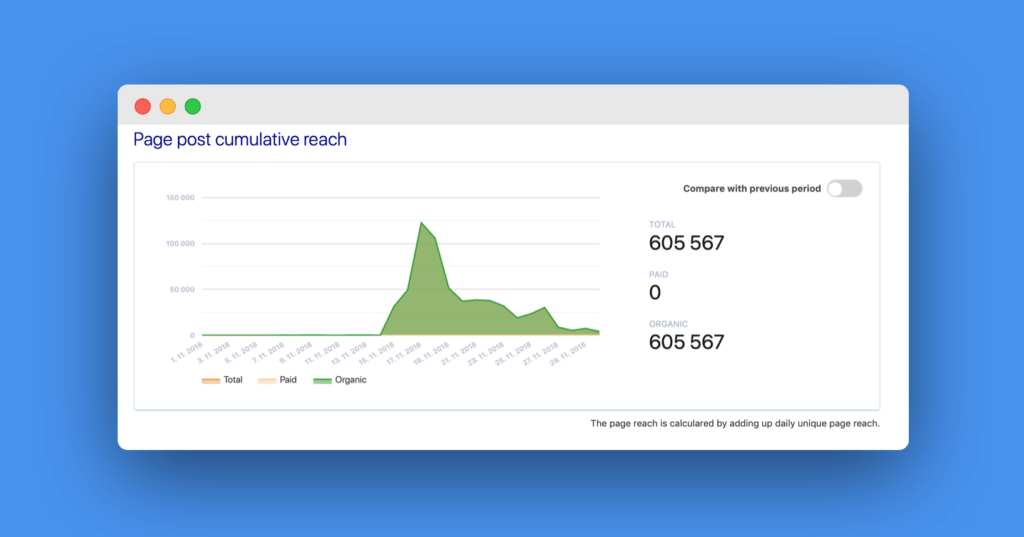
What makes it different from Facebook Insights? You are not overloaded with data and you can take your time to read and understand them. For example, you can see the peak of reach on that particular page. Social media managers should spend time analyzing what that peak was caused by and find out how social media analytics can help in repeating this success. Many Facebook analytics tools do not deliver data in such a clean, user-friendly way. Also, you can see here Facebook marketing analytics if you used any campaigns.
With Kontentino, numbers are put into reports and conclusions, and data is put into context. Even if you are not an analytical pro, you will be able to read statistics and take advantage of the results. No more wondering why one post performed well, and another one didn’t hit the spot.
Insights & Reporting tab helps you with:
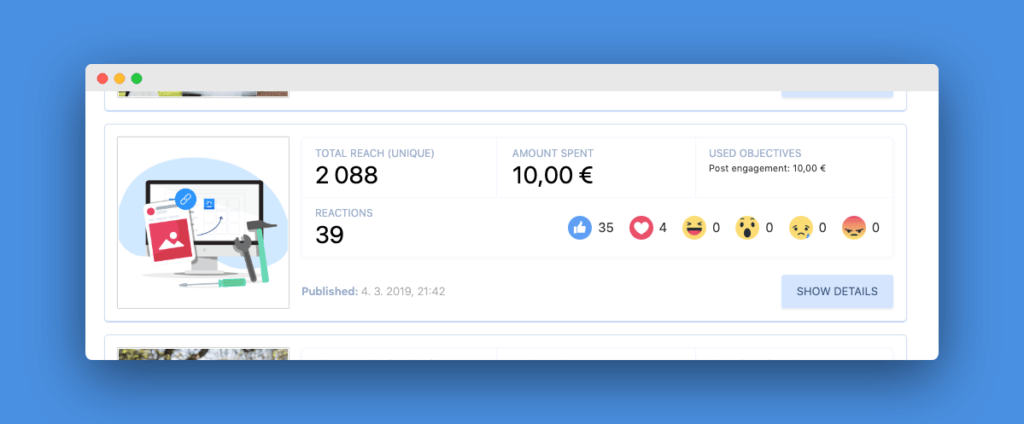
Since the results are shown in a simple and very transparent way, you’ll no longer have problems with reading them correctly and make some analysis or comparison between the selected pieces of content.
You can analyze separate posts as you are given very detailed statistics that, additionally, are explained further.
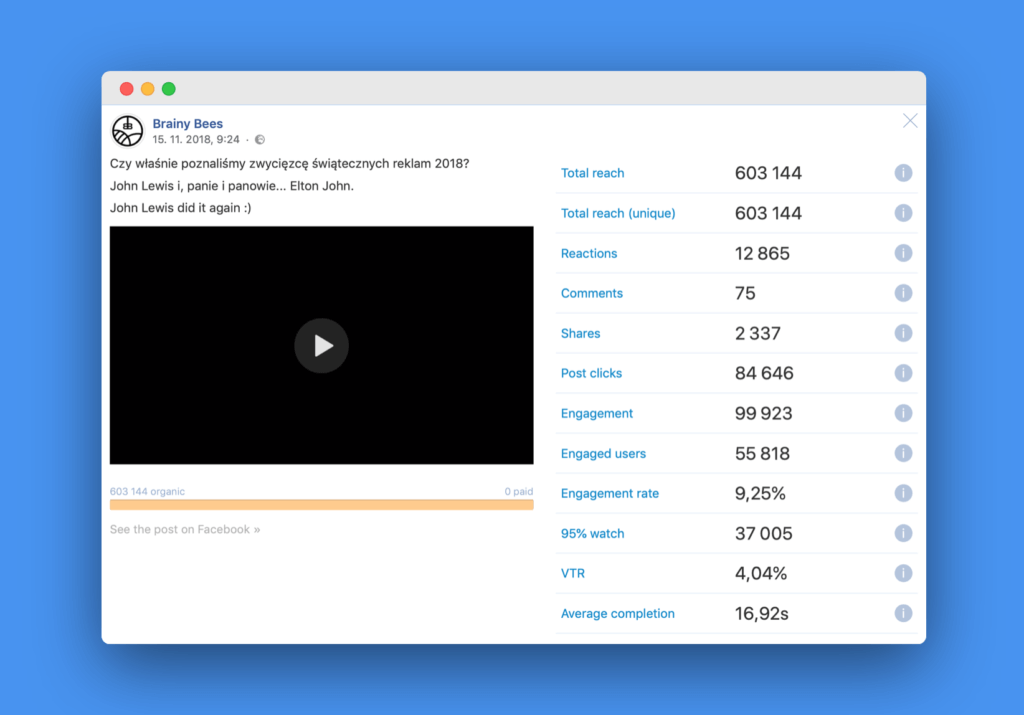
Above, you can see a set of metrics. This is where understanding social media analytics come in handy. While the number of shares looks impressive, the average completion of the video is fairly short (the clip is 90 seconds long), the number of comments could always be higher and the engagement rate is below 10%. However, if you bear in mind that video reached more than 600 thousand unique Facebook users organically, you can take it as a small success.
You honestly do not have to be an analytical pro (however, you should be aiming for it!), but you need to understand how social media analytics can help you improve your performance. Facebook ad analytics can help you recognize areas for improvement and areas you are great at. We know that understanding social media analytics is not easy: that is why in Kontentino you can access and generate reports that will make all those numbers at least a bit easier for you. Good luck!